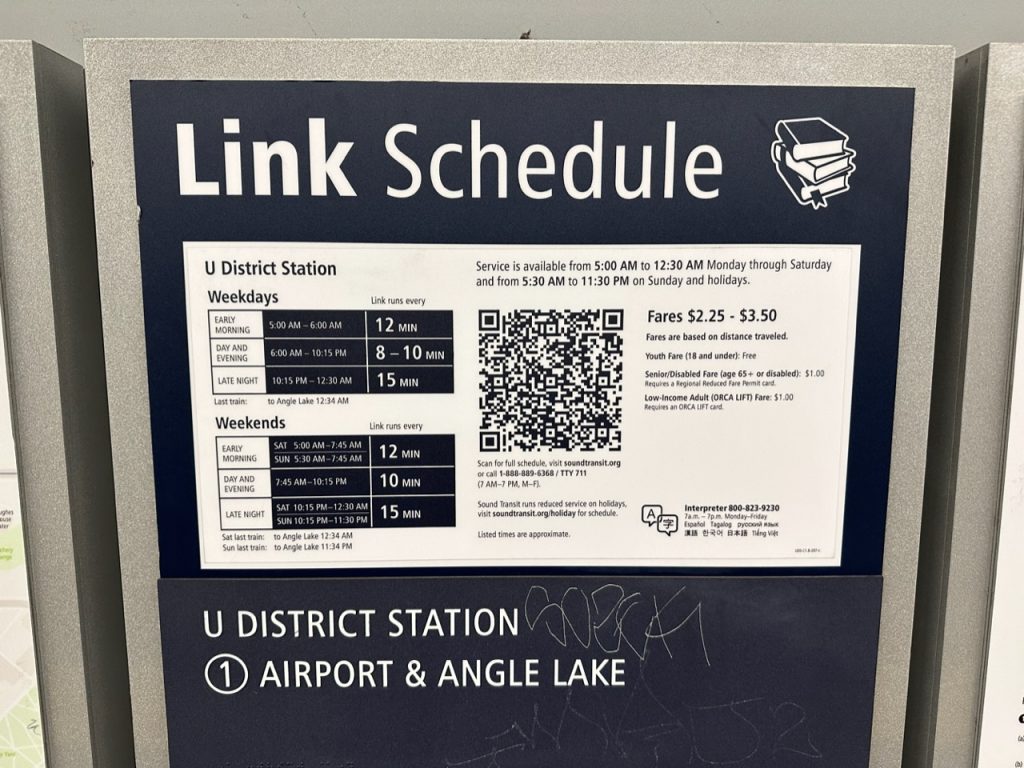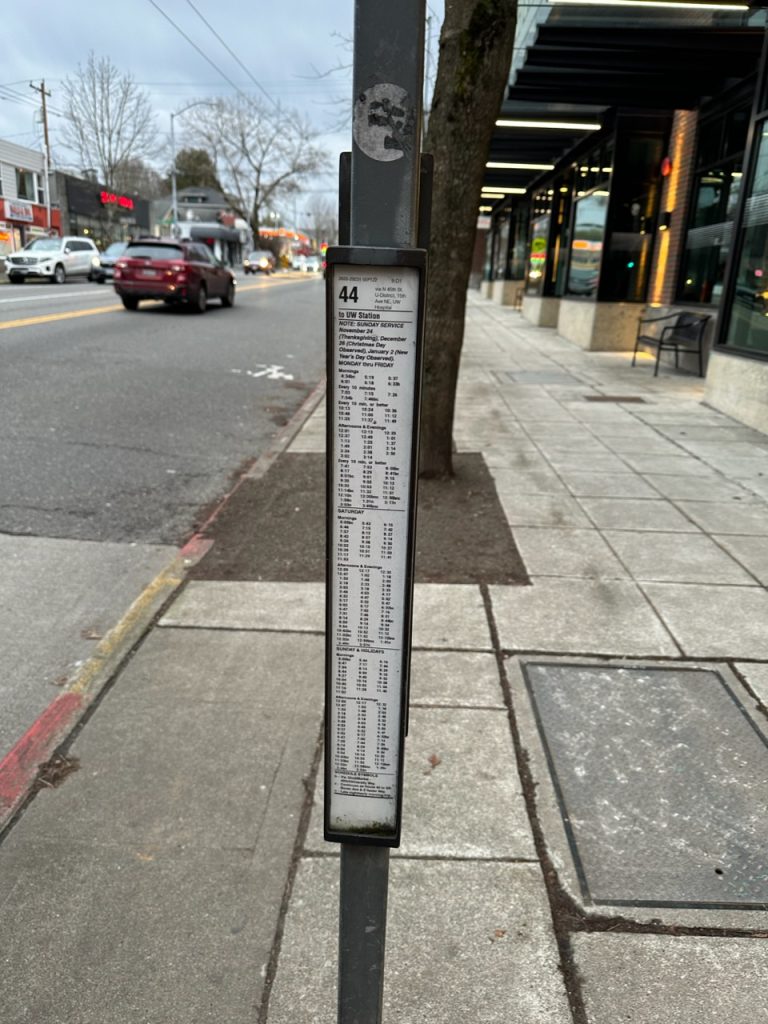Gold standard ‘Stem-and-Leaf’ visuals clearly convey frequency and provide accountability.
In Puget Sound, transit riders live by schedules. They have places to go and their time is precious. Posted schedules help them make decisions about which options might suit them best and sets their expectations. Local transit agencies understand this and generally offer these in some form at transit stops, but the ones that do exist could use an update to improve their usefulness.
Before we get to what an alternative might be and why it would be better, let’s dive into the schedule solutions we do have.
The existing posted schedule paradigm
Sound Transit and King County Metro both publish schedules for their services, but what’s available online versus what’s found at stations and stops is very different.
Sound Transit posts what it claims to be Link “schedules” at stations, but these don’t usually tell riders what time a train is actually supposed to depart from a platform. Instead, these schedules generally tell riders what the frequencies are by period of the day. Only a two-minute warning announcement actually lets riders know when a train might be coming. Conversely, Sound Transit’s online timetable offers pages of detailed trip times for the Link 1 Line.
For Metro’s part, bus stop signs get posted schedules and they are comparably detailed, but they’re hard to parse and sometimes still omit individual trips in favor of frequency. The printed and online timetables do much a better job of informing riders in this regard.
Eventually, Sound Transit is supposed to restore digital real-time information signs (RTIS) at Link stations, but the exact timing remains unknown. Metro also has slowly been adding digital real-time information signs at stops, but these will only serve a very small sliver of stops outside of those near Link stations and along the RapidRide system. And none of this is a true supplement for a posted schedule.
Defined schedules are less important when transit service is arriving every five or fewer minutes. In Puget Sound, that’s not the transit we have here. Longer wait times add up and make riders choosy about when they want to make their trips. Posting schedules with “10-minute frequency from 8am to 10pm” may sound simple and appealing to transit planners, but this neither makes the wait time seem reasonable nor predictable to a rider. That’s why publishing a full schedule is critical in aiding decision-making and reducing anxiety of riders.
Riders often consult phone apps providing real-time arrival information, including Metro’s Trip Planner, Transit App, and OneBusAway, so that they know a more precise (though still not perfect) estimate of when a bus is actually coming given all too frequent delays. However, not all riders have working smartphones and these services can suffer outages or fail to track a bus that a rider is counting on. Transit agencies need to offer a quality analog alternative to ensure riders have enough information.
An alternative approach: stem-and-leaf
Both Sound Transit and Metro could benefit from publishing a new kind of schedule: a stem-and-leaf schedule. Many riders who have traveled abroad will be familiar with this type of schedule. It’s a gold standard in publishing scheduled trip times.
The basic idea of stem-and-leaf is that the hour is the stem while the minute trip time is the leaf. This makes it much easier to parse trip times than wading through a snaking list of numbers like Metro’s bus stop sign schedules. It also makes it possible to know when a train is suppose to depart on the 1 Line during modest frequency service period — that’s all operating hours right now. With a full posted schedule, riders can be more assured that when they step onto the platform during a 12-minute frequency period that their train is probably only eight minutes away.
Adapting stem-and-leaf schedules to the Puget Sound context presents a big opportunity to both simplify information and add in some extra key pieces of information. Below are three mock-ups: two for Link stations (Northgate and SODO) and one for a Metro bus stop sign. (Tap on the images for larger versions.)



Certainly additional information could be included in the stem-and-leaf schedules, but these mock-ups at least offer a window into what can be done.
Adhering to schedules is a challenge right now
Of course, no schedule is foolproof, and riders know that. Traffic snarls, collisions, and onboard emergencies can and do delay service and even send everything off-schedule. Lack of staffing and equipment can also be serious causes for schedule failures. Transit is struggling right now and it’s been especially hard for Puget Sound transit agencies to adhere to schedules.
A peek behind the curtain on Sound Transit’s dashboard shows that Link on-time performance, which is defined as arriving within five minutes of the scheduled arrival time, has been lackluster. The last reported data point in October reveals that 88% of trips were on-time and that on-time performance had generally been well below 90% over the previous 11 months. Future Ready maintenance certainly affected some of this, but it only explains a small part.
Meanwhile, entire national rail systems — including war-torn ones — have been operating with higher punctuality than Seattle’s transit and with tighter on-time definitions. Metro has its own problems that are worse than on-time performance. The agency is regularly canceling more than 4% of scheduled trips on the average weekday due to staffing levels, and that’s been tough for riders to stomach as hundreds of trips are being each weekday.
This all makes stem-and-leaf posted schedules more important.
If Sound Transit and Metro issue improved stop schedules, it raises the visibility of those schedules and demands more accountability from them. Riders will benefit from a tool that daylights trip times for them and offers other pertinent information about the service they want to use. It also helps riders have better expectations about that service and puts more pressure on agencies to adhere to schedules as much as possible. If we’re doomed to face lower frequencies for now, getting the operations schedule piece right is the least we should be striving for. Stem-and-leaf schedules are an answer to all of this and worth a try.
Stephen is a professional urban planner in Puget Sound with a passion for sustainable, livable, and diverse cities. He is especially interested in how policies, regulations, and programs can promote positive outcomes for communities. With stints in great cities like Bellingham and Cork, Stephen currently lives in Seattle. He primarily covers land use and transportation issues and has been with The Urbanist since 2014.





